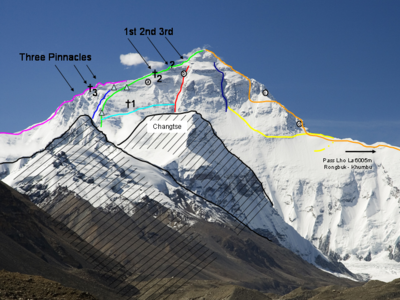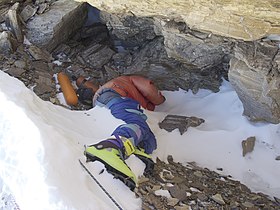Three Steps

TheThree Stepsare three prominent rocky steps on the northeast ridge ofMount Everest.They are located at altitudes of 8,564 metres (28,097 ft), 8,610 metres (28,250 ft), and 8,710 metres (28,580 ft). TheSecond Stepis especially significant both historically and in mountaineering terms. Any climber who wants to climb on thenormal routefrom the north of the summit must negotiate these three stages.

TheFirst Stepconsists of large boulders that pose a serious obstacle, even for experienced climbers, because of their location high in theDeath Zone.Many mountaineers have died near the First Step, among them "Green Boots",a corpse wearing neon green climbing boots and a red coat, which serves as a somber landmark for climbers to gauge their distance to the top, and which has now been possibly identified asTsewang Paljor.[1]His fellow climbers, who also perished on the same day as he in 1996, areTsewang SmanlaandDorje Morup.[1]Other climbers have died under that rock as well, namelyDavid Sharp.
TheSecond Stepis the best known of the rocky steps. The steep section, at an altitude of 8,610 m, has a climbing height of 40 metres (130 ft), of which the last five are almost vertical. The step was apparently climbed for the first time in 1960 whenWang Fuzhou,Gongbuand Qu Yinhua claimed to have completed thefirst ascent via the north ridge,with their teammateLiu Lianmanvolunteering to be a human ladder up the step. Despite being widely accepted, there is inconclusive evidence to support the claim. The climbing difficulty of this spot was reduced in 1975 when a Chinese team affixed analuminiumladder to the step that has been used since then by almost all climbers. In 2007, out of safety considerations, the original 15 feet (4.6 m) ladder was replaced with a new one by Chinese and international mountaineers. The original ladder is now on display at the Mount Qomolangma Museum in Tibet.[2]
TheThird Stepis easiest to climb. Its climbing height is about 10 metres (33 ft), after which the summit snowfield is reached.
Important climbs of the Second Step
[edit]The1921 British Mount Everest reconnaissance expeditionwas the first to attempt to climb Mount Everest. It was followed by further British expeditions in1922,1924,and1933.The climbers had to make the ascent from the north, since Nepal was closed. The situation became reversed after the communist victory in theBattle of Chamdo;expeditions launched after that had to use the southern approach through Nepal.[3]The technical difficulties, especially in climbing the Second Step, were still unknown. There is ongoing discussion as to whether the Second Step was ever surmounted byGeorge MalloryandAndrew Irvinein 1924. It was surmounted in 1960 as part ofthe first ascent of Mount Everest via the north route,when a shoulder stand was used to climb the last 5 metres (16 ft).
The step was first climbed unaided in 1985, by the SpaniardÒscar Cadiach.He assessed the final rock face as5.7 to 5.8(V+ in UIAA classification). Theo Fritsche, an Austrian, climbed the step in 2001free soloon-sightand came to a similar conclusion.Conrad Ankerclimbed the Second Step in 1999 and assessed the level of difficulty as 5.10. On this ascent Anker supported himself using the Chinese ladder. In 2007, Anker repeated the climb withLeo Houlding;this time, however, he first removed the ladder in order to climb the stepunaided.[4]
Sources
[edit]- Mantovani, Roberto and Diemberger, Kurt (1997).Mount Everest – Kampf in eisigen Höhen.Moewig.ISBN3-8118-1715-9
- Hemmleb, Jochen (2009).Tatort Mount Everest: Der Fall Mallory – Neue Fakten und Hintergründe.Herbig, Munich.ISBN978-3-7243-1022-8.
See also
[edit]References
[edit]- ^abNuwer, Rachel(October 2015)."The tragic tale of Mt Everest's most famous dead body".BBC.Retrieved12 March2016.
- ^"Chinese Ladder Retires".crienglish.com.Beijing, China:China Radio International.28 May 2008. Archived fromthe originalon 23 November 2019.Retrieved5 May2023.
- ^Shipton, Eric.The Mount Everest Reconnaissance Expedition 1951.
- ^Viesturs, Ed.The Mountain: My Time on Everest, p 176.

